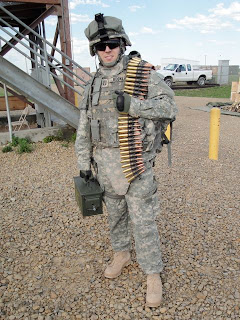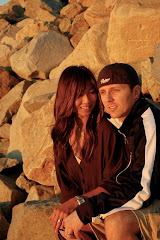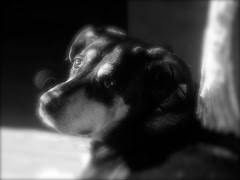Let's shoot more stuff...
M9 Qualification
After a short, but entertaining weekend, we're back at it again. This time, we were heading to the range to fire our personal weapons, the M9 (9 mm pistol) and M4 (rifle...similar to the M16). Our wake up call for this evolution was not quite as bad as the 0430 alarm just a few days earlier for our range day on the big weapons. And, in standard fashion, you can see I was sporting the "cup o' Jo" again. We're really roughin' it, huh?

(That's not a gang sign...alla Ironman...it means day 2 on the range.)
Our first task for this morning was to qualify on the 9 mm pistol. After the safety brief near the bleachers, we moved out in groups to receive our magazines with a particular number of rounds loaded into each one. Magazines, in this case, are the cartridges full of ammunition that are loaded into the weapon...not variably interesting viewpoints by journalists assimilated on paper...sorry, bad attempt at humor...this journaling thing is tough.
Approaching the range, there were two rows of mounded dirt at 5, 10, 15, 20 and 25 meters intervals, in front of each firing sector. (see the first two pictures below) The sector (or lane) is the area an individual will fire in. Having been given a chance to fire a few rounds for familiarization, we proceeded into the qualification. Unfortunately, I can't remember the sequence of the pop-up targets, but the general idea was have our pistols at the "low ready" position (which means pointed at the dirt...away from your neighbor) and fire upon the targets as they popped up. As the targets pop up, one only has a few seconds before it disappears...so you have to be on your toes. For anyone who hasn't fired a pistol...or even those that have, it's not as easy as it sounds. But, we all qualified and moved on to the M4 evolution.
Ready to draw my "9".
Part of the team waiting around after shooting the M9.
M4 Qualification
(M4 firing range beyond the tower.)
The M4 range was a bit more complex than the M9. Having traveled up the road to a different range (actually, it was range next door), we began by "sighting in" our weapon. Initially we sighted in our "iron sights". Sounds tough, doesn't it..."iron sights". Truth be told, these are the sight posts anchored to the weapon; one near the barrel and one near the trigger. We fired at a paper target approximately 25 meters away. Initially, we shot for a "group", which means we fired a single round, three times and walked to the target to check our marks. If our group was within a 4 cm square area, we would start adjusting either our far "iron sight" up or down, or the near "iron sight" left or right. Each time we would fire three single rounds and check our positioning.
(Sighting in the "iron sights"...the first group is in the lower right corner and the next two groups show me moving closer to center mass.)
After this was accomplished, we sighted in our M68...the laser scope. With this scope, we don't use our iron sights at all. Rather, once the laser is sighted in, we look through the scope and put the little red dot on the target and fire. I believe this was made for goofballs like me who have rarely fired a gun...very easy. The "sighting in" portion of the M68 was very similar to that of the iron sights. Again, first we shoot for a "group" and then adjust a "traversing" (right or left) or "elevation" dial to march our group closer to the "center mass" of the target...center mass basically refers to the bull's eye. The only way this works, is if the shooter has the same sight picture every time. This means, I will always look at the same point on the paper target (center mass) and shoot my three rounds. Therefore, the targeting mechanism moves, not my view of the sight picture. I know I didn't explain that very well, so feel free to ask me about it later.
(M68 Laser sighting in...progressively, each group moves towards center mass.)
Once our M4's were sighted in, we moved down to the qualification range and collected our ammunition. There were between 16-18 lanes on this range. As we moved out to our respective lanes, we were met by an instructor who would be with us during the entirety of the shoot. His job...as was the case, all were men...was to help us maintain safety with the weapon and direct us as to which targets were going to pop up. These targets were set between 50 and 300 meters, at intervals of 25-50 meters. Honestly, I can't remember where each one was. Anyway, the targets were green silhouettes of people that would fall down once hit, though I think many of my targets that were broken...because they didn't go down...OK, maybe I'm making that up.
For the qualification, the initial phase was spent standing in a fox hole (a cement box built into the ground) with our M4 supported on sand bags.
(My teammate firing from the "fox hole" and the instructor to his left.)
We used one 20 round magazine for 20 targets. The second phase consisted of a 10 round magazine for 10 targets in the fox hole, unsupported by the sand bags. Finally, the third phase was conducted out of the fox hole, in the kneeling position; firing 10 rounds for 10 targets. This last position of firing was the most difficult. It's amazing how tired one becomes over the course of the qualification and how hard it is to steady your weapon without any support. But, I believe this is part of the intent, to familiarize us with the weapon, our proficiencies, and limitations. Overall, I shot 31 out of 40 targets for a designation of "Sharp Shooter". Not bad for my first time. We have some pretty good shooters on our Navy-Army team, and a couple scored at the Expert level...36/40.
We were done with the daytime qualification by 1100 and headed back to the barracks for a little "R & R". As with the larger "Crew Serve" weapons on the prior range day, we still needed to come back for the nighttime qualification.
Back at the range by 2000, we received our safety brief and had our PEC 2 Infrared Lasers sighted in by the instructors. Wait a minute..."what is a PEC 2?" you ask. Well, this is another laser sight on our M4 that allows us to target objectives at night, while wearing our night vision goggles (NVG's). It's a very cool device. Essentially, while wearing the NVG's, you turn on your PEC 2 and point your weapon down range. Once you see the bright, light-green dot on the target...Fire! Due to the nature of this laser, you don't even need to look through your sights, rather you can "shoot from the hip" so to speak. One interesting point about this night shoot is that unless there is some ambient light source creating enough light to see the target, or the target is holding a light, you can't necessarily see them. So, as each target popped up, a flashing light would appear, center mass. Now, because most of our enemy would not click a flashlight on and off at us repeatedly, the flashing light was to simulate gunfire from the end of their weapon...clever. Again, we had 40 targets. However, all of our shots were from the standing fox hole position. And again, I got a "Sharp Shooter" classification...couldn't break into the Expert level.
This was a lot of fun and my instructor, Staff Seargent Keller, was very cool and very helpful.
To top it off, we weren't out at the range until 0500 the next morning either. I think we finished up by 2300 and were home by 2330...beautiful.
(Some of my teammates hanging out in the bleachers following their qualifications.)
(Mike, aka "Fifty Cal", just chillin'.)
(I don't know who this is, but he keeps popping up in my pictures.)

























.jpg)







